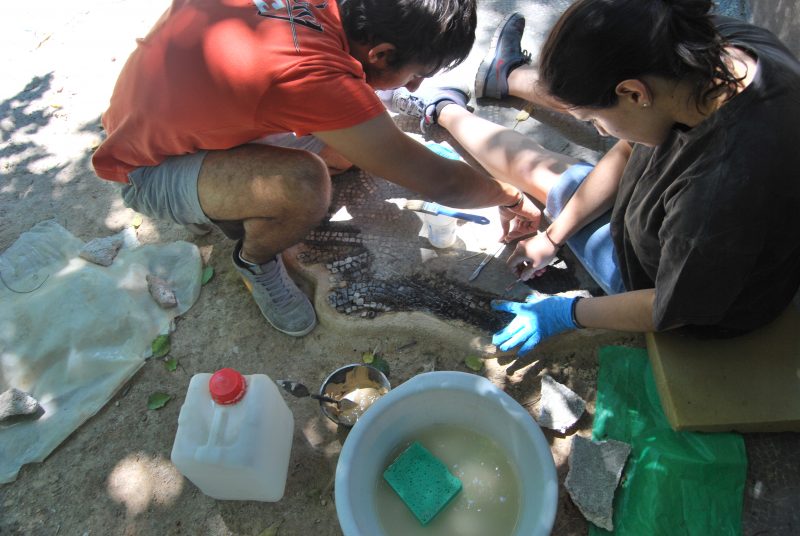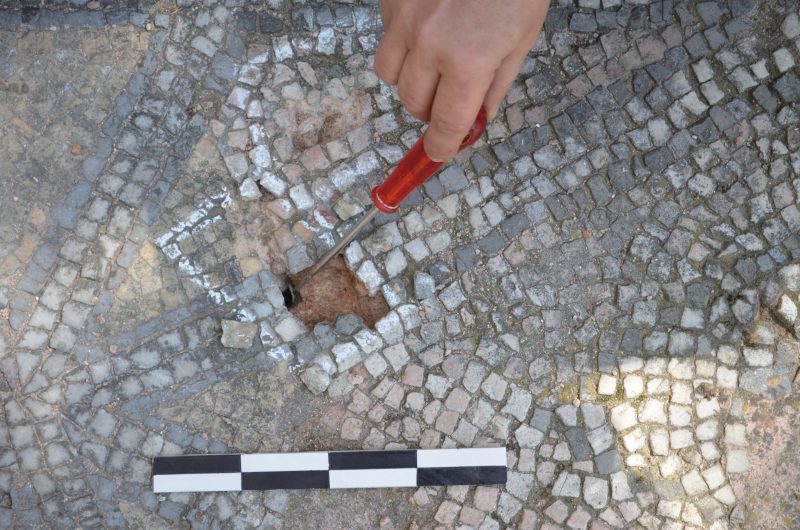


Course Content
Mosaics are examined as an integral part of the architectural context in which they are found. However, the course also considers museum exhibits, which feature a large number of mosaics that have been detached from their original architectural context and need conservation or regular maintenance.
Theory: 2 hours per week -13 weeks
The theoretical part of the course includes lectures in the following thematic areas:
– The historical evolution of mosaics: style and function
– Materials and Techniques
– Weathering factors
– Weathering forms
– Pathology
– Documentation techniques
– Ethical aspects in mosaic conservation
– In situ conservation of mosaics: a review of remedial treatments
– In situ conservation of mosaics: a review of preventive measures
– Detachment and mounting of mosaics
– Systematic monitoring and maintenance of mosaics
– Presentation of mosaics: in situ and ex situ
Lab – field session
Conservation practice: 6 hours per week, 13 weeks
The practical part of the course includes both laboratory sessions and field work and provides the students with significant hands-on experience.
In the laboratory sessions the students examine various types of rocks and glass with different cutting properties, they test traditional and modern cutting tools, they practice tesserae setting and finally they test mounting methods and materials.


Hand-on practise takes place at an archaeological site in Athens under the auspices and in collaboration with the Directorate of Conservation of Ancient and Modern Monuments and the Archaeological Ephorate Greek Ministry of Culture. Students have the opportunity to undertake a condition survey of in situ and re-laid mosaics and to participate in the annual maintenance work on the mosaics. They are actively involved in the examination of the mosaics, the documentation of their condition by means of photogrammetry and the identification and mapping of weathering forms. Moreover, they investigate into the weathering factors affecting the mosaics and the potential threats and they draft a proposal for the conservation and protection of the mosaics based on the study of the data that is collected and recorded during the field work and taking into account the principles and ethics which apply in the field of mosaic conservation.
Expected Learning Outcomes
By the end of the course students should have acquired the necessary knowledge and skills to:
- undertake a condition survey at mosaic site or monument
- accurately document the mosaics
- study the materials and the technological characteristics of mosaic works
- identify and record weathering patterns
- identify weathering factors and their effects
- evaluate the condition of the mosaics and the potential threats
- undertake a series of remedial treatments to the mosaics, such as cleaning, consolidation, grouting, integration of lacunas
- work with a team of conservators and other professional in developing a sustainable conservation and presentation plan for the mosaics of the site.
Course Structure
The course includes lectures, seminars, laboratory practice, fieldwork, study and analysis of bibliography, tutorials, educational visits, field project, essay writing.
The student’s study hours for each learning activity are given at the beginning of the course as well as the hours of non-directed study according to the principles of ECTS STUDENT ASSESSMENT
Language of evaluation: Greek (English for Erasmus students).
Student Evaluation
The student’s final grade is determined by averaging 50% of the theoretical part grade and 50% of the laboratory practice grade.
Students’ evaluation (100%):
THEORY (50%)
Essay (20%)
Written exams (30%)
LAB PRACTICES (50%):
Laboratory Work and Field Work (35%)
Group report – written (5%)
Personal work report – written (5%)
Presentation (5%)
SUGGESTED BIBLIOGRAPHY
Greek:
Χαραλάμπους Ε., 2012, Τεχνολογία κατασκευής των επιδαπέδιων ψηφιδωτών της Κύπρου
Ασημακοπούλου-Ατζακά Π., 2003, Ψηφιδωτά δάπεδα, Προσέγγιση στην τέχνη του αρχαίου ψηφιδωτού, University Studio Press.
Κολέφας Γ., (1983), Η τέχνη του Ψηφιδωτού, Εκδόσεις ΕΟΜΜΕΧ
Foreign:
Ξενόγλωσση:
Bakirtzis, Ch. (ed.), (2005), Wall and floor mosaics: conservation, maintenance, presentation, Proceedings of the VIIIth Conference of the International Committee for the conservation of mosaics (ICCM), Thessaloniki, 29 October – 3 November 2002, Greece Ben Abed A.(ed), 2006 Stories in Stone, Conserving Mosaics of Roman Africa, Getty Publications, Los Angeles, California, 188 pp.
Ben Abed A., (2006), Tunisian Mosaics, Treasures from Roman Africa, Conservation and Cultural Heritage, Getty publications, Los Angeles, California Ben Abed A., (ed.) 2008, Lessons learned: Reflecting on the Theory and Practice of Mosaic Conservation, proceedings of the 9th International Committee for the Conservation of Mosaics, Hammamet, Tiunisia, 29 Nov-3 Dec 2005, Getty publications, Los Angeles, California Blanc P., Blanc-Bijon, V., 2003, Les mosaïques: conserver pour présenter? VIIème conférence du Comité international pour la conservation des mosaïques, International Committee for the Conservation of Mosaics (ICCM), 22-28 Novembre 1999, Arles,
France Bowersock G. W., (2006), Mosaics as History, The Near East from Late Antiquity to Islam, Harvard University Press, Cambridge, Massachusetts, London, UK.
Dunbabin, K. M. D., (2001), Mosaics of the Greek and Roman World, Cambridge University Press De la Torre, M (ed). 1998, The conservation of archaeological sites in the Mediterranean region, (Symposium Proceedings), Getty Publications
Jobst, W., Erdal, B., Gurtner C., (1997), Istanbul The Great Palace Mosaic, Arkeoloji ve Sanat Yayinlari, Turkey, 96 pp. Jokiletho J., (2005), A History of Architectural Conservation, D. Phil Thesis, University of York, England, Institute of Advanced Architectural Studies, 1986, recomposed in PDF format, February 2005. www.iccrom.org/pdf/ICCROM_05_HistoryofConservation00_en.pdf
Michaelides, D., (2003), Mosaics make a site: the conservation in situ of mosaics on archaeological sites, Proceedings of the VIth Conference of the International Committee for the Conservation of Mosaics (ICCM), Nicosia, Cyprus 1996, ICCROM, GETTY, ICCM
MOSAICS No1, 1978, Mosaics, Deterioration and conservation, Proceedings of the first International Symposium on the Conservation of Mosaics, Rome, 2 – 5 November 1977, ICCROM, Rome. –
Related Journals
Conservation and Management of Archaeological Sites, Taylor & Francis
Journal of Cultural Heritage, Elsevier
Journal of Archaeological Science, Elsevier
Websites
https://www.getty.edu/projects/mosaikon/


